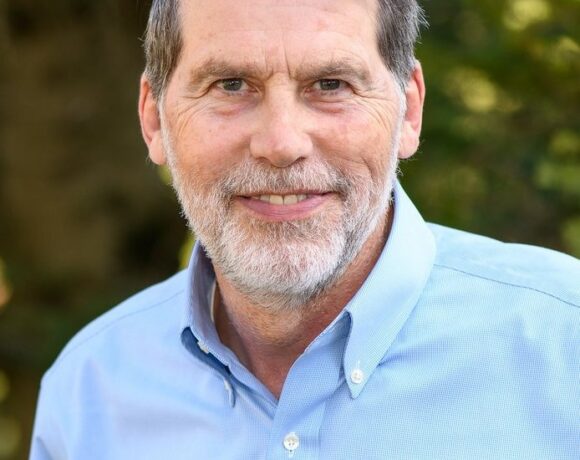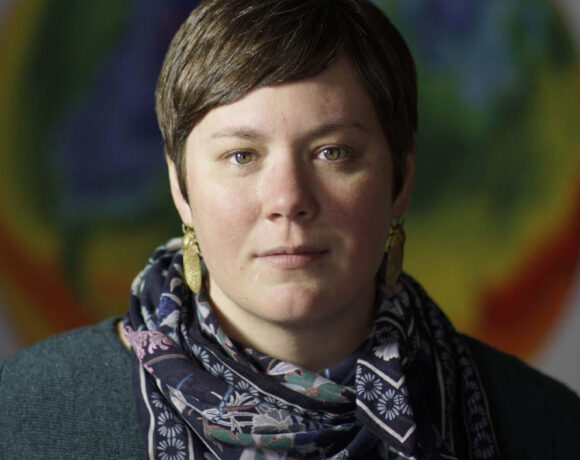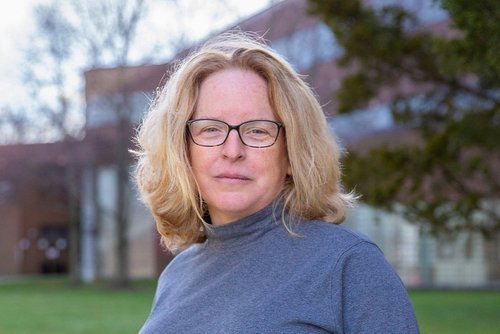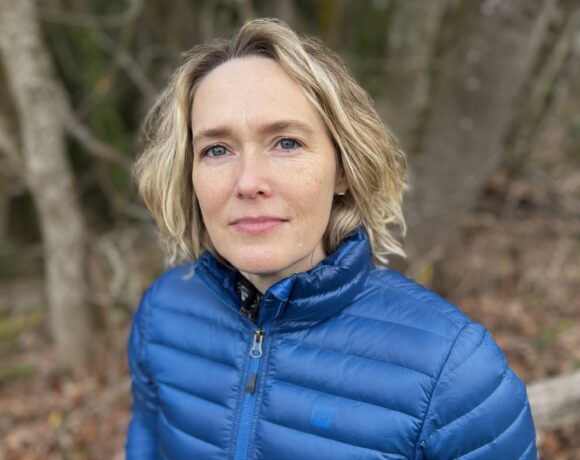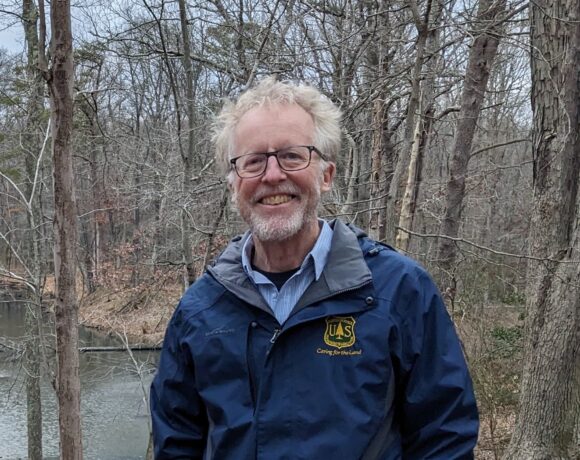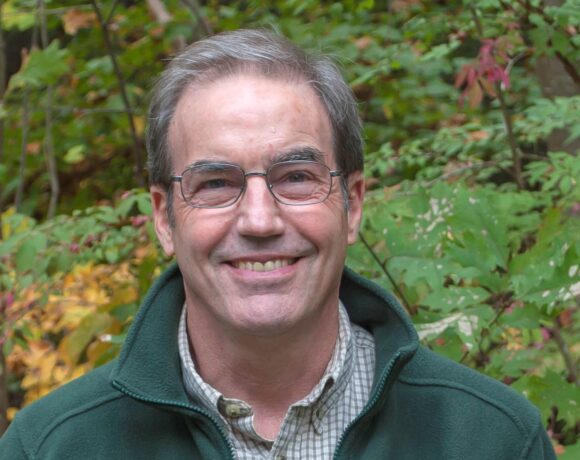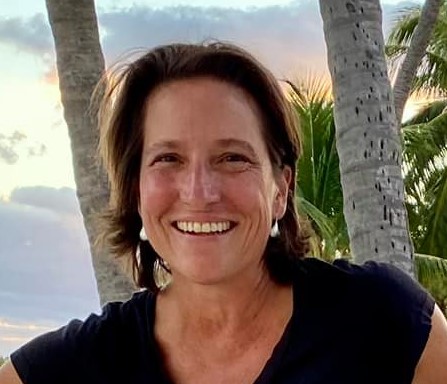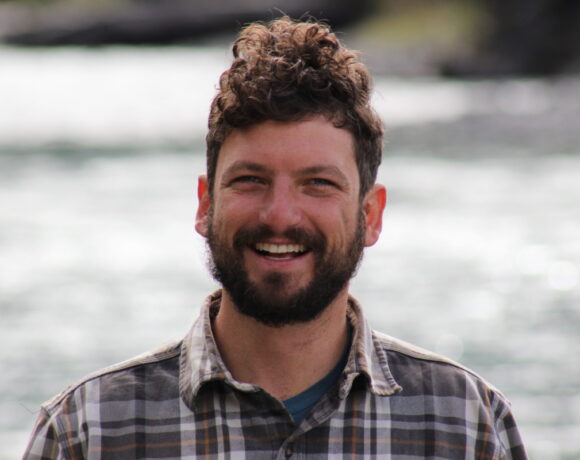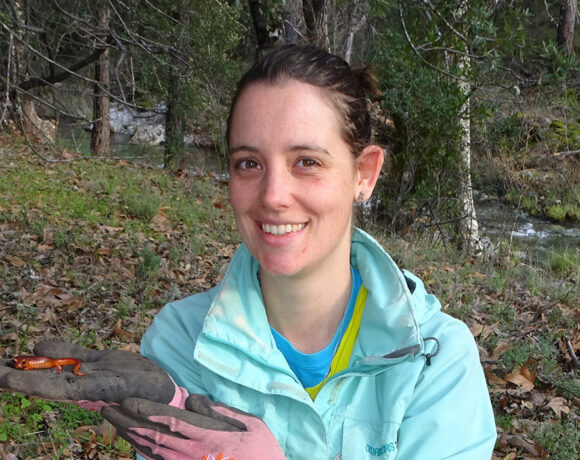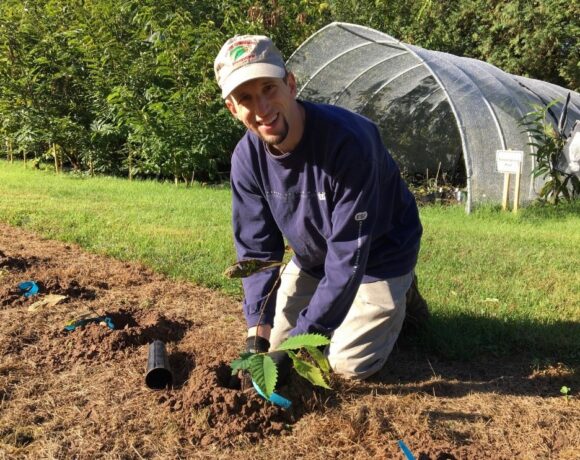This month, we connected with Jennifer Andreas, who has worked in biological control for the last 25 years, and provides integrated weed management strategies and education to land managers in Washington State. She also serves as co-chair of the NAISMA Biocontrol Committee.
Watch the interview here:
View transcript:
Justin Dalaba (JD):
All right. So, I’m here with Jenn Andreas today and we’re going to be hearing a bit about your work and involvement with biocontrol implementation and extension. So just to kind of start out, I wanted to give you the platform and have you share with me – I know you kind of wear several pretty important hats. So, tell me about your position with Washington State University and some of the other roles that you’re involved in.
Jennifer Andreas (JA):
Thanks for having me today. So, I am a professor in extension within Washington State University and within that capacity, I’m the weed biocontrol specialist for Washington State. So, I don’t work on other kinds of biocontrol. It’s very specific to invasive plants. As you mentioned, I wear a lot of hats. I’m kind of involved in way too many projects. Which for better or for worse, it’s pretty fun, but there are really two that kind of have taken up a lot of my time in the last few years. The first is that I lead the flowering rush biocontrol consortium and so this is a group dedicated to developing biocontrol agents for the aquatic weed flowering rush, which I know is present in New York. The other role that takes up a lot of my time is I’m Co-chair of the North American Invasive Species Management Association, or NAISMA, I’m Co-chair of the classical biocontrol committee. And so this committee is really focusing on providing biocontrol education and advancing weed biocontrol issues, so there’s lots more, but those are probably the biggest ones at the moment.
JD:
Yeah, that’s awesome. It’s a really important topic in invasive species management currently. And so, I’d love to hear about your journey to becoming involved with invasive species management at a national scale and as an international collaborator. So how did you land where you are today? What kind of brought you down this path?
JA:
So, I’ve been in weed biocontrol for a lot of years since, I think I started in 1998. I originally started my education in landscape design and pretty quickly realized it was terrible at it, but I had a real passion and completely fell in love with my entomology and invasive plant coursework. And then it was in my invasive plant work where I learned about classical biocontrol as a management tool for weeds. And so, it really shifted my career at that point to moving into that direction. So, I am from Canada and so I moved to work on a bachelor’s degree in University of Lethbridge because there’s a agriculture and Agri Food Canada research station in Lethbridge and so I wanted to work with that group. It was through that group where I had my first international experience, where I worked over at CABI in Switzerland, which is where they do a lot of development of biocontrol. And so, from there I then moved up to the University of Idaho, and I did a Master’s degree in Entomology, where I studied the environmental safety of a biocontrol agent that is approved in Canada but not in the U.S., which is kind of a really interesting and big topic that’s pretty detailed and complicated. And from there I took a job, a part-time job at WSU to be the Western Washington Weed Biocontrol coordinator. And from there I really grew it statewide. And I think because I have such strong partners from a variety of different places, it’s really allowed me to continue to grow into all these different avenues. You know, in terms of still partnering with CABI in Switzerland and also working with my Canadian collaborators and then lots of weed biocontrol people down here in the states. So, you know, we’re a fairly small community, but there’s lots of opportunity for working on different projects.
JD:
Yeah, that’s so awesome to hear how you’ve kind of been able to connect the dots and build on those existing collaborations as you’re sort of growing and evolving in that role. And to use your words, I know you said you have your hands in quite a few different cookie jars. So, if you could speak kind of generally to what are the primary goals of your work and current collaborations? I’d love to hear that.
JA:
Yeah, I probably should mention that my program is almost entirely granting contract funded. So, generally my goals tend to be really funder driven. And I thankfully, that that has been really beneficial. It’s allowed me to do lots of different projects, but it definitely does direct me. So, I really think of my program as having sort of three main veins: implementation, outreach and research. So, for implementation, I’m working with land owners and land managers across Washington state to redistribute and establish biocontrol agents. And then we study their impacts once they’ve been released. And so, I’m working with really tons of different partners, lots of agencies, tribal, federal, state, county and then even just your local landowner to make sure we can get biocontrol on the ground, you know, as widespread as possible. In the last few years, I’ve really been focused on releasing and studying newer biocontrol agents and then we’ve been doing a lot of post fire implementation. In terms of outreach, the outreach vein, I give a lot of presentations and I create educational material using a bunch of different mediums and through different venues. And then the third vein is research, and I’m involved in several different projects, probably one of the biggest ones right now is the flowering rush biocontrol development project. And although I’m not directly involved in the day-to-day research, because that’s all happening with our CABI partners overseas. I do help drive that project forward and bring partners together. So last year we submitted a petition for field release of a flowering rush Weevil, and we’re hoping it will be approved within a couple of years. And so, we’re starting to look at what release will look like in Montana. That’s where the first releases will happen in the states. So, what that will look like in Montana in the next couple of years, so we’ll be conducting pre and post release research, which will ultimately help us determine if the insect has established and whether it’s been effective. I’m also leading the knotweed project for Washington State, so we have a brand new biocontrol agent that was approved in 2020. There’s two different strains, so I’m working on implementing and studying the psyllid on both our giant and Bohemian knotweed populations. And then the last one, which I’ll just really briefly cover because it’s too much detail is I’ve been conducting long-term studies to assess the impacts of our Scotch broom biocontrol agents. So Scotch broom doesn’t really impact most people, but on the West Coast from California up to British Columbia, it’s a pretty serious weed. And so, we’ve been looking at what the potential long-term impacts of the biocontrol agents we’ve been releasing for decades will look like. So that that’s kind of a brief overview of just some of the things that I’ve got my hands into.
JD:
That’s all?
JA:
That’s all.
JD:
Wow, that’s quite a busy array of projects, and I’m hoping to, I guess, have you sort of walk me through briefly what is the path to the biocontrol implementation actually look like? Just for those who are unfamiliar. And then to elaborate on a little bit more of why it matters in the context of invasive species.
JA:
So, for implementation really for me, what happens here in Washington is land owners or land managers from lots of different, as I said, agencies or local people will contact me when they’re considering using biocontrol as a management tool. And the first thing we need to do is figure out if biocontrol makes sense for their weed populations, because it doesn’t always make sense and so we want to make sure that this is the right tool for them. And then we also have to have a conversation about what their overall site goals are. And you know, if they’re looking for eradication, biocontrol won’t be a good fit. And we also want to have a conversation about their expectations. So, a lot of people expect biocontrol will work similar to a herbicide and it’s so we really want to talk to them about how does biocontrol work and manage the expectations around what should they expect to see. So that they don’t end up feeling disappointed when maybe it doesn’t work like an herbicide does. So, once we determine that biocontrol is appropriate for them, then within my program we collect biocontrol agents from the field and we redistribute them during the field season and we send them out or we release them ourselves to land managers. And then we try to go back in subsequent years to determine whether they’ve established. So, we want to know if the biocontrol agents are there and if they’re doing anything. So anytime, especially when we have, newer biocontrol agents, it’s really important for us to establish pre and post release monitoring. This will helps us sort of assess the impacts of biocontrol on those weed populations. This can take many years, so this is one thing that can be really challenging for people is to understand that biocontrol is a fairly slow process. So it can take many years of data collection to demonstrate those impacts, but it can be really powerful in in demonstrating the value of biocontrol to land managers when they’re trying to achieve their management goals. So that’s really what implementation looks like from put the insects down or the biocontrol agents down on the ground to what we ultimately want to say about them. I always try to really stress that biocontrol is an equally valuable weed management tool alongside herbicide, mechanical, physical and cultural control methods. So, all of these play an important role in order for us to achieve our goals of reducing invasive plant impacts. And it’s also important to think about how biocontrol can be incorporated with the other tools, because incorporating as many tools as possible will help us achieve our goals faster. And so that’s always a conversation I try to have with people is let’s think about biocontrol is not a stand-alone tool, but as a tool that can really be used in a in a broader sense with our with our strategies. Does that answer the question?
JD:
Absolutely, I really appreciate that perspective and I wanted to drill in a little deeper on a couple of the points that you made. So you know, as you mentioned, biocontrol can be a really promising management approach in certain contexts, but it’s also one that’s really laden with complexities, whether it’s public misperceptions, the actual path to approving that agent… So I’d love to hear your perspective on what are some of those, the biggest obstacles to advancing a new biocontrol agent?
JA:
Well, unfortunately, the biggest obstacle is really funding. So, when we are trying to fund a new biocontrol agent program, it can be extremely difficult to acquire the funding to do that. And so we’re often pulling together multiple sources of funding in order to conduct the work that needs to happen. So the projects are… biocontrol in the initial phases can be quite expensive to do the testing, find the potential biocontrol agents. All of that can be rather expensive. The long-term cost benefit is very much in the favor of biocontrol being ultimately very cost effective because once we put a biocontrol agent on the ground, you know, that’s a long term management technique in comparison to say herbicides which you have to spray again and again and again. So that’s a constant source of funding that has to go into that, so funding can be really challenging. There are other barriers like you know, we have to figure out how an organism’s life cycle in order to be able to rear it or test it. It can be challenging to acquire biocontrol agents from their native range. And then the testing itself, host specificity or impact testing, can be can be quite challenging too, and takes sometimes a lot of work to get that right. But generally sort of the overarching thing is those challenges can typically be overcome if there’s sufficient funding available in the long run. That’s probably the biggest obstacle. Always money.
JD:
As is true across disciplines and science especially, and to kind of follow on that, I’m wondering if you could speak to any bigger successes that you’ve seen or any case study examples that you can, I guess share with us, that you’ve seen in your involvement or your work with biocontrol.
JA:
Yeah, so what success means for weed biocontrol is a pretty interesting topic. And I don’t think any of us really have a really clear, nailed down idea. Obviously if we see weeds being really dramatically reduced, that’s success, but there’s lots of other kinds of successes we see as well. So I’d say for me, I kind of think of success in a couple of different ways. In terms of on the ground success, I think that our post-fire work has been pretty significant. So as you probably know, Washington has had some pretty massive wildfires in the last five plus years. And generally what happens is the biocontrol agents are wiped out, but the weeds really thrive. And makes it a real problem because the weeds have come back and there is nothing managing them. And so I’ve been working with tribal, federal and state agencies to rapidly reintroduce biocontrol agents after a fire. In order to get them reestablished as quickly as possible. And we’ve seen some really great successes. Dalmatian toadflax, diffuse knapweed. So here in the West, those are huge issue weed problems where we have pretty successful biocontrol agents. But they do get wiped out and so we reintroduce them when we see fairly rapid reductions of our weeds. So I think that kind of stuff really demonstrates the value of how using biocontrol can help us manage these massive weed infestations that emerge after a fire. On the other side, I think we could measure success in terms of our development looking at our flowering rush project. I’ve been super impressed by the collaborative effort, number of partners who contribute to moving this flowering Rush project forward. It’s only with the support because we’ve had such amazing support for this project that we’ve been able to advance really quickly and there’s a lot of excitement about having that potential biocontrol agent available soon. So, you know, we still don’t know what that’s going to look like on the ground, but moving something forward, having lots of great partners, just sort of makes a world of a difference, and so I consider that a success.
JD:
Yeah, I love that you include that example of, you know, increasing collaborations and ultimately support for whatever you’re working towards is definitely an important aspect of success. And I recognize that’s also a complicated question because we are in this discourse across invasive species management in general of how do we define success? And we’re constantly redefining that and figuring out, you know what that looks like on the landscape. So yeah, thanks for sharing those examples and your perspective on. I guess kind of thinking more towards the future, I wanted to hear from you, if you have kind of a long term goal with your work, you know what’s your hope with your current role in collaborations?
JA:
So you know, I try to really always keep top of mind what our goal is and that is reducing impacts of invasive plants. And so, you know, it’s easy to get down a rabbit hole in different topics, but like if our goal is ultimately reducing that, how do I think, you know the work I’m doing will help with that? And so I think the implementation efforts is really incredibly important. So getting insects or biocontrol agents down on the ground is really important, and I hope that I all of our efforts will see long term impacts. I think our post release monitoring data can help us demonstrate those impact. For me, I have seen really great success stories and so, for me it is really exciting to see land managers get excited too, so I get excited and then I can see that they get excited that they’re maybe they were a little skeptical about biocontrol, but they are now seeing changes in their weed populations. I also hope that my outreach efforts will contribute to a greater understanding, acceptance and support of biocontrol. And then you know kind of full circle, I hope that through our research work we are able to continue bringing biocontrol agents into North America or the U.S. and making them available for widespread distribution. So really you know, we don’t want to get stuck with the same biocontrol agents. We have new weeds coming in, so we really want to have biocontrol agents available for them.
JD:
Yeah, absolutely. And I guess kind of still in the same vein. I’m curious. If you’re willing to share what lies ahead for you, is there something you’re particularly involved excited about being involved in or that’s kind of in the works right now?
JA:
Yeah, I think, well, we’ll definitely continue on with the knotweed project, so we’re only, this is our third year in, so there’s still lots to learn. So continuing to try to get the psyllids established in Washington. The flowering rush project is still going, and it’s really exciting. We have two potential biocontrol agents still being studied. Now that we will hopefully have the weevil approved for release here in the States. It’s already approved in Canada. We’ll be able to start doing a lot of really on the ground research there and it’s super challenging system. So there’s lots to learn, and I’m looking forward to working with my partners on that. We’ll be continuing with my outreach. We are finalizing a biocontrol curriculum, sort of a biocontrol 101 course for NAISMA. And we’re also, I’m working with partners and experts in biocontrol to build up and expand the ibiocontrol.org website. I don’t know if you’ve ever been there, but it has lots of great tools and we’re really hoping to make it a clearinghouse for anyone looking for biocontrol resources, so hopefully stay tuned for that, but ibiocontrol.org will hopefully be a really awesome tool for people. And then I just always like to stick to my implementation routes and make sure that we’re getting out with people and I’m helping them get biocontrol agents on the ground and looking for impact. So it’s probably, you know, kind of sticks in my same vein of the three program goals.
JD:
Yeah, I love to hear that you’re still engaging on the ground. And it’s also, I mean, kind of reconnecting to why we all are so inspired in the 1st place to protect these ecosystems. You have to get out there and be involved in the work, so definitely never a dull moment in your world. You’ve got a lot going on. And I know we covered a lot, so I wanted to just, I guess round this out with one last question, which is, is there anything we didn’t cover that you wanted to share?
JA:
Yeah, I think really I just want to acknowledge that I do all of this work with a whole lot of amazing people. So, this is a partnership that even though I’m at WSU, there’s lots of people who are doing really phenomenal work and none of that would be possible without us all collaborating. And so, it’s too many people to mention. This is my Oscar speech, but I would definitely like to give them a shout out so that you know to acknowledge that this is not me just doing all of this work. And then finally, I’m really grateful for the opportunity to reach a broader audience and talk about weed biocontrol with you. People are welcome to reach out to me directly if they have questions, and I can either answer them or I can try to direct people to who might be able better answer their questions.
JD:
Yeah, well, I’m really grateful for you opening up your schedule for us to be able to have this conversation and for opening your door for others to connect with you with further questions. So Jenn, I wanted to thank you so much for your time. This has been an awesome conversation and I’m really looking forward to sharing it with our network in the Northeast.
JA:
Wonderful. Thanks, Justin.
Additional resources:
Biocontrol resources: https://www.ibiocontrol.org/
General biocontrol info on NAISMA website: https://naisma.org/naisma-resources/biocontrol/
Weed and Biocontrol Factsheets: https://naisma.org/naisma-resources/biocontrol/biocontrol-factsheets/
Biocontrol Summit 2022: https://www.youtube.com/watch?v=J3AtQYssjyE
More researcher spotlights:



